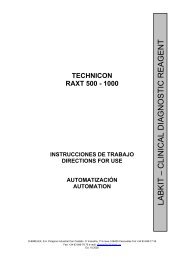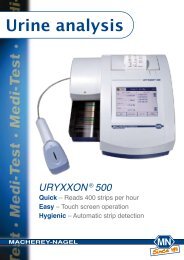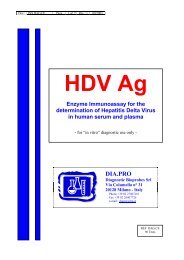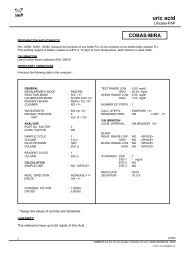[SAS-MX Acid Hb]. - Agentúra Harmony vos
[SAS-MX Acid Hb]. - Agentúra Harmony vos
[SAS-MX Acid Hb]. - Agentúra Harmony vos
- No tags were found...
Create successful ePaper yourself
Turn your PDF publications into a flip-book with our unique Google optimized e-Paper software.
REFERENZWERTEBei der Geburt besteht der Hauptanteil des Hämoglobins in den Erythrozyten normaler Neugeboreneraus fetalem Hämoglobin (<strong>Hb</strong>F). Es sind außerdem ein gewisser Anteil <strong>Hb</strong>A, dem Hauptanteil desErwachsenenhämoglobins, und ein geringer Anteil an <strong>Hb</strong>A 2 vorhanden. Der Hauptanteil desHämoglobins am Ende des ersten Lebensjahres und beim Erwachsenen ist das <strong>Hb</strong>A, mit einem <strong>Hb</strong>A 2 -Anteil von bis zu 3,7% und weniger als 2%<strong>Hb</strong>F.LEISTUNGSEIGENSCHAFTENa) ReproduzierbarkeitDas <strong>SAS</strong>-<strong>MX</strong> Säure <strong>Hb</strong> Gel ist ein qualitatives System zur Identifizierung von Hämoglobinbanden.Bei Einsatz von Kontrollmaterial, das die Hämoglobine <strong>Hb</strong>A, S und A 2 enthielt, wurden die gleichenBandenmuster innerhalb des einzelnen und zwischen den verschiedenen Gelen beobachtet.Zwischen den Auftragungen fehlten keine Bande und es wurden auch keine zusätzlichen Bandebeobachtet.b) EmpfindlichkeitDie Sensitivität beträgt 0,08g/dl pro Bande und wurde durch die niedrigste Hämoglobin-Konzentration ermittelt, die als eine diskrete Bande auf dem fertigen Gel zu sehen war.c) LinearitätDie Linearität beträgt 4g/dl. Sie basiert auf der maximalen Hämoglobinkonzentration pro Band, diees erlaubt, getrennte Bande zufrieden stellend ohne Eiweißüberladung voneinander zu isolieren.Diese Methode ist nicht zum densitometrischen Scannen bestimmt.LITERATUR1. Wintrobe, Maxwell M., Clinical Hematology, 6th Edition, Lea and Febiger, Philadelphia, 1967.Seite 145-167.2. Fairbanks, V.F., 'The Nomenclature and Taxonomy of Hemoglobin Variants', Diagnostic Medicine,Nov/Dec., 53-58, 1980.3. Schneider, R.G., Hightower, B.J. and Barwick, R.C., 'Laboratory Identification of the Hemoglobins',Lab Management, 1981; August: 29-43.4. Center for Disease Control, Laboratory Methods for Detecting Hemoglobinopathies, U.S.Department of Health and Human Services/Public Health Service, 1984.5. Schneider, R.G.,' Methods for Detection of Hemoglobin Variants and Hemoglobinopathies in theRoutine Clinical Laboratory', CRC Critical Reviews in Clinical Laboratory Sciences, 1978.6. Schneider, R.G., Hightower, B., Hosty, T.S., Ryder, H., Tomlin, G., Atkins, R., Brimhall, B., andJones, R.T.,'Abnormal Hemoglobins in a Quarter Million People', Blood, 1976; 48(5) : 629-637.7. Huisman, T.H.J. and Schroeder, W.A., 'New Aspects of the Structure, Function and Synthesis ofHemoglobins'. CRC Press, Cleveland, 1971.8. Schmidt, R.M., Huisman, T.H.J.,and Lehmann, H., The Detection of Hemoglobinopathies. CRCPress, Cleveland, 1974.9. Weatherall, D.J. and Clegg, J.B., The Thalassemia Syndromes, Blackwell Scientific Publications,Oxford, 1972.10. Lehman, H. and Huntsman, R.G., Man's Haemoglobins, J.B. Lippincott Co., Philadelphia, 1974.18


![[SAS-MX Acid Hb]. - Agentúra Harmony vos](https://img.yumpu.com/46129828/20/500x640/sas-mx-acid-hb-agentara-harmony-vos.jpg)

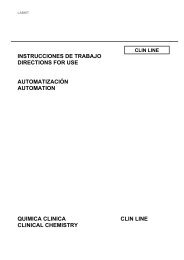
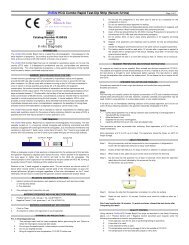
![[APTT-SiL Plus]. - Agentúra Harmony vos](https://img.yumpu.com/50471461/1/184x260/aptt-sil-plus-agentara-harmony-vos.jpg?quality=85)


![[SAS-1 urine analysis]. - Agentúra Harmony vos](https://img.yumpu.com/47529787/1/185x260/sas-1-urine-analysis-agentara-harmony-vos.jpg?quality=85)



